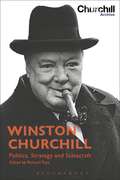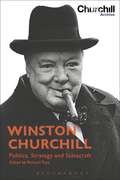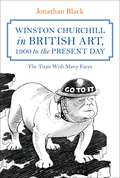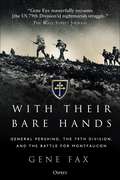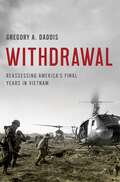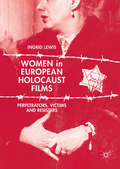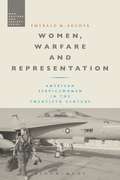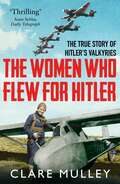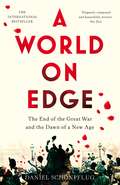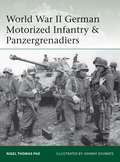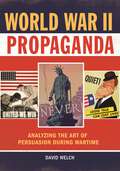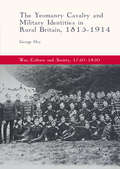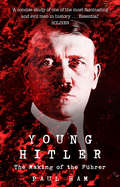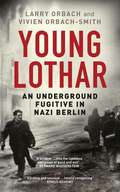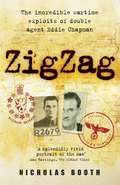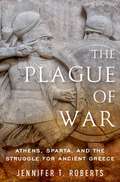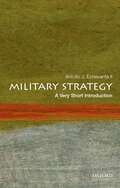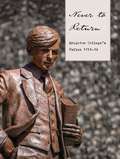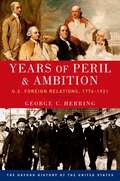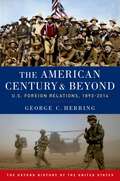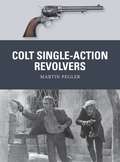- Table View
- List View
Winston Churchill: Politics, Strategy and Statecraft
by Richard ToyeWinston Churchill is a renowned historical figure, whose remarkable political and military career continues to enthral. This book consists of short, highly readable chapters on key aspects of Churchill's career. Written by leading experts, the chapters draw on documents from Churchill's extensive personal papers as well as cutting–edge scholarship. Ranging from Churchill's youthful statesmanship to the period of the Cold War, the volume considers his military strategy during both World Wars as well as dealing with the social, political and economic issues that helped define the Churchillian era. Suitable for those coming to Churchill for the first time, as well as providing new insights for those already familiar with his life, this is a sparkling collection of essays that provides an enlightening history of Churchill and his era.
Winston Churchill: Politics, Strategy and Statecraft
by Richard ToyeWinston Churchill is a renowned historical figure, whose remarkable political and military career continues to enthral. This book consists of short, highly readable chapters on key aspects of Churchill's career. Written by leading experts, the chapters draw on documents from Churchill's extensive personal papers as well as cutting–edge scholarship. Ranging from Churchill's youthful statesmanship to the period of the Cold War, the volume considers his military strategy during both World Wars as well as dealing with the social, political and economic issues that helped define the Churchillian era. Suitable for those coming to Churchill for the first time, as well as providing new insights for those already familiar with his life, this is a sparkling collection of essays that provides an enlightening history of Churchill and his era.
Winston Churchill in British Art, 1900 to the Present Day: The Titan With Many Faces
by Jonathan BlackChurchill is today remembered as a great leader, a war hero, a literary heavyweight and a renowned wit. This incarnation of Churchill is the latest in a long-evolving identity, which at various times has sustained his power, enhanced his popularity and enabled him to personify aspects of British national identity.Indeed Churchill was more aware than most of the performative power of his public life. He lived in an age of the illustrated mass-produced newspaper, with its cartoons and 'Kodak-snappers'. He was well-known for his readiness to appear in uniform for photo opportunities during the Second World War and he not only wrote about the art of political caricature, but collected cartoons of himself, his allies and opponents.In this heavily-illustrated book, Jonathan Black considers the changing image of Churchill in visual art, from cartoons and paintings to photographs and sculptures. He asks how and why his image developed right up to the present day and examines the extent to which Churchill was complicit in its production.
With Their Bare Hands: General Pershing, the 79th Division, and the battle for Montfaucon
by Gene FaxWith Their Bare Hands traces the fate of the US 79th Division – men drafted off the streets of Baltimore, Washington, and Philadelphia – from boot camp in Maryland through the final years of World War I, focusing on their most famous engagement: the attack on Montfaucon, the most heavily fortified part of the German Line, during the Meuse-Argonne Offensive in 1918. Using the 79th as a window into the American Army as a whole, Gene Fax examines its mistakes and triumphs, the tactics of its commander General John J. Pershing, and how the lessons it learned during the Great War helped it to fight World War II. Fax makes some startling judgments, on the role of future Army Chief-of-Staff, Colonel George C. Marshall; whether the Montfaucon battle – had it followed the plan – could have shortened the war; and if Pershing was justified in ordering his troops to attack right up to the moment of the Armistice. Drawing upon original documents, including orders, field messages, and the letters and memoirs of the soldiers themselves, Fax tells the engrossing story of the 79th Division's bloody involvement in the final months of World War I.
Withdrawal: Reassessing America's Final Years in Vietnam
by Gregory A. DaddisA "better war." Over the last two decades, this term has become synonymous with US strategy during the Vietnam War's final years. The narrative is enticingly simple, appealing to many audiences. After the disastrous results of the 1968 Tet offensive, in which Hanoi's forces demonstrated the failures of American strategy, popular history tells of a new American military commander who emerged in South Vietnam and with inspired leadership and a new approach turned around a long stalemated conflict. In fact, so successful was General Creighton Abrams in commanding US forces that, according to the "better war" myth, the United States had actually achieved victory by mid-1970. A new general with a new strategy had delivered, only to see his victory abandoned by weak-kneed politicians in Washington, DC who turned their backs on the US armed forces and their South Vietnamese allies. In a bold new interpretation of America's final years in Vietnam, acclaimed historian Gregory A. Daddis disproves these longstanding myths. Withdrawal is a groundbreaking reassessment that tells a far different story of the Vietnam War. Daddis convincingly argues that the entire US effort in South Vietnam was incapable of reversing the downward trends of a complicated Vietnamese conflict that by 1968 had turned into a political-military stalemate. Despite a new articulation of strategy, Abrams's approach could not materially alter a war no longer vital to US national security or global dominance. Once the Nixon White House made the political decision to withdraw from Southeast Asia, Abrams's military strategy was unable to change either the course or outcome of a decades' long Vietnamese civil war. In a riveting sequel to his celebrated Westmoreland's War, Daddis demonstrates he is one of the nation's leading scholars on the Vietnam War. Withdrawal will be a standard work for years to come.
Women in European Holocaust Films: Perpetrators, Victims and Resisters
by Ingrid LewisThis book considers how women’s experiences have been treated in films dealing with Nazi persecution. Focusing on fiction films made in Europe between 1945 and the present, this study explores dominant discourses on and cinematic representation of women as perpetrators, victims and resisters. Ingrid Lewis contends that European Holocaust Cinema underwent a rich and complex trajectory of change with regard to the representation of women. This change both reflects and responds to key socio-cultural developments in the intervening decades as well as to new directions in cinema, historical research and politics of remembrance. The book will appeal to international scholars, students and educators within the fields of Holocaust Studies, Film Studies, European Cinema and Women’s Studies.
Women in European Holocaust Films: Perpetrators, Victims and Resisters
by Ingrid LewisThis book considers how women’s experiences have been treated in films dealing with Nazi persecution. Focusing on fiction films made in Europe between 1945 and the present, this study explores dominant discourses on and cinematic representation of women as perpetrators, victims and resisters. Ingrid Lewis contends that European Holocaust Cinema underwent a rich and complex trajectory of change with regard to the representation of women. This change both reflects and responds to key socio-cultural developments in the intervening decades as well as to new directions in cinema, historical research and politics of remembrance. The book will appeal to international scholars, students and educators within the fields of Holocaust Studies, Film Studies, European Cinema and Women’s Studies.
Women, Warfare and Representation: American Servicewomen in the Twentieth Century (War, Culture and Society)
by Emerald M. ArcherWomen, Warfare and Representation considers the various ways the American servicewoman has been represented throughout the 20th century and how those representations impact the roles she is permitted to inhabit. While women have a relatively short history in the American military, the last century shows an evolution of women's direct participation in war despite the need to overcome societal sex-role expectations. The primary focus is on the American case, but Emerald Archer also introduces a comparative element, showing how women's integration in the military differs in other countries, including Great Britain, Canada and Israel. Adopting an interdisciplinary approach, the book draws on military history, theory and social psychology to offer a more complete and integrated history of women in the military and their representation in society.
Women, Warfare and Representation: American Servicewomen in the Twentieth Century (War, Culture and Society)
by Emerald M. ArcherWomen, Warfare and Representation considers the various ways the American servicewoman has been represented throughout the 20th century and how those representations impact the roles she is permitted to inhabit. While women have a relatively short history in the American military, the last century shows an evolution of women's direct participation in war despite the need to overcome societal sex-role expectations. The primary focus is on the American case, but Emerald Archer also introduces a comparative element, showing how women's integration in the military differs in other countries, including Great Britain, Canada and Israel. Adopting an interdisciplinary approach, the book draws on military history, theory and social psychology to offer a more complete and integrated history of women in the military and their representation in society.
The Women Who Flew for Hitler: The True Story of Hitler's Valkyries
by Clare MulleyHanna Reitsch and Melitta von Stauffenberg were talented, courageous and strikingly attractive women who fought convention to make their names in the male-dominated field of flight in 1930s Germany. With the war, both became pioneering test pilots and both were awarded the Iron Cross for service to the Third Reich. But they could not have been more different and neither woman had a good word to say for the other.Hanna was middle-class, vivacious and distinctly Aryan, while the darker, more self-effacing Melitta, came from an aristocratic Prussian family. Both were driven by deeply held convictions about honour and patriotism but ultimately while Hanna tried to save Hitler's life, begging him to let her fly him to safety in April 1945, Melitta covertly supported the most famous attempt to assassinate the Führer. Their interwoven lives provide a vivid insight into Nazi Germany and its attitudes to women, class and race.Acclaimed biographer Clare Mulley gets under the skin of these two distinctive and unconventional women, giving a full - and as yet largely unknown - account of their contrasting yet strangely parallel lives, against a changing backdrop of the 1936 Olympics, the Eastern Front, the Berlin Air Club, and Hitler's bunker. Told with brio and great narrative flair, The Women Who Flew for Hitler is an extraordinary true story, with all the excitement and colour of the best fiction.
A World on Edge: The End of the Great War and the Dawn of a New Age
by Daniel SchönpflugA World on Edge reveals Europe in 1918, left in ruins by World War I. With the end of hostilities, a radical new start seems not only possible, but essential, even unavoidable. Unorthodox ideas light up the age like the comets that have recently passed overhead: new politics, new societies, new art and culture, new thinking. The struggle to determine the future has begun.The sculptor Käthe Kollwitz, whose son died in the war, was translating sorrow and loss into art. Ho Chi Minh was working as a dishwasher in Paris and dreaming of liberating Vietnam, his homeland. Captain Harry S. Truman was running a men’s haberdashery in Kansas City, hardly expecting that he was about to go bankrupt – and later become president of the United States. Professor Moina Michael was about to invent the 'remembrance poppy', a symbol of sacrifice that will stand for generations to come. Meanwhile Virginia Woolf had just published her first book and was questioning whether that sacrifice was worth it, while the artist George Grosz was so revolted by the violence on the streets of Berlin that he decides everything is meaningless. For rulers and revolutionaries, a world of power and privilege was dying – while for others, a dream of overthrowing democracy was being born.With novelistic virtuosity, historian Daniel Schönpflug describes this watershed year as it was experienced on the ground – open ended, unfathomable, its outcome unclear. Told from the vantage points of people, famous and ordinary, good and evil, who lived through the turmoil and combining a multitude of acutely observed details, Schönpflug composes a brilliantly conceived panorama of a world suspended between enthusiasm and disappointment, and of a moment in which the window of opportunity was suddenly open, only to quickly close shut once again.
World War II German Motorized Infantry & Panzergrenadiers (Elite #218)
by Johnny Shumate Nigel ThomasIn World War II Germany's doctrine of mobile warfare dominated the battlefield. By trial and error, the Germans were the first to correctly combine the strength in tanks and in mobile infantry and artillery. This integration of mobile units, equipment and tactics underpinned Germany's successes in the first half of the war. As the war dragged on, the Allies sought to copy German tactics but German armies remained supreme in this type of warfare until their losses had seriously degraded their capabilities. This study traces the development of the different types of unit that came together in the Panzergrenadier branch from the inter-war years through World War II. Using colour plates to display the changes in uniform, equipment and insignia in all theatres of operations throughout the conflict, this is a complete account of Hitler's elite armoured infantry.
World War II Propaganda: Analyzing the Art of Persuasion during Wartime
by David WelchShows in illuminating detail how the Allied and Axis forces used visual images and other propaganda material to sway public opinion during World War II.Author David Welch provides a neatly organized primary resource that focuses on key themes associated with World War II propaganda. Readers will not only be engrossed with a wide range of propaganda artifacts, they will also receive a better and more nuanced understanding of the nature of this propaganda and how it was disseminated in different cultural and political contexts. This book reveals how leaders and spin doctors operating at behest of the state sought to shape popular attitudes both at home and overseas. A comprehensive introductory essay sets out the principles of propaganda theory in World War II, while the subsequent material provides examples of Allied- and Axis-generated propaganda and presents them in a readily accessible way that will help readers understand the context.
World War II Propaganda: Analyzing the Art of Persuasion during Wartime
by David WelchShows in illuminating detail how the Allied and Axis forces used visual images and other propaganda material to sway public opinion during World War II.Author David Welch provides a neatly organized primary resource that focuses on key themes associated with World War II propaganda. Readers will not only be engrossed with a wide range of propaganda artifacts, they will also receive a better and more nuanced understanding of the nature of this propaganda and how it was disseminated in different cultural and political contexts. This book reveals how leaders and spin doctors operating at behest of the state sought to shape popular attitudes both at home and overseas. A comprehensive introductory essay sets out the principles of propaganda theory in World War II, while the subsequent material provides examples of Allied- and Axis-generated propaganda and presents them in a readily accessible way that will help readers understand the context.
The Yeomanry Cavalry and Military Identities in Rural Britain, 1815–1914
by George HayThis volume represents the first dedicated study of the British Yeomanry Cavalry, delving into the institution’s history from the cessation of hostilities with France in 1815 through to the eve of the First World War in 1914. This social history explores the Yeomanry’s composition and place within British society, as well as its controversial role in policing before and after Peterloo, and its unique contribution to the war in South Africa. Overturning or challenging many enduring myths and accepted truths, this book breaks new ground not just in our understanding of the Yeomanry, but the wider amateur military tradition.
The Yeomanry Cavalry and Military Identities in Rural Britain, 1815–1914
by George HayThis volume represents the first dedicated study of the British Yeomanry Cavalry, delving into the institution’s history from the cessation of hostilities with France in 1815 through to the eve of the First World War in 1914. This social history explores the Yeomanry’s composition and place within British society, as well as its controversial role in policing before and after Peterloo, and its unique contribution to the war in South Africa. Overturning or challenging many enduring myths and accepted truths, this book breaks new ground not just in our understanding of the Yeomanry, but the wider amateur military tradition.
Young Hitler: The Making of the Fuhrer
by Paul HamWhen Adolf Hitler went to war in 1914, he was just 25 years old. It was a time he would later call the 'most stupendous experience of my life'. That war ended with Hitler in a hospital bed, temporarily blinded by mustard gas. The world that he opened his newly healed eyes on was new and it was terrible: Germany had been defeated, the Kaiser had fled and the army had been resolutely humbled. Hitler never accepted these facts. Out of his fury rose a white-hot hatred, an unquenchable thirst for revenge against the 'criminals' who had signed the armistice, against the socialists who he accused of stabbing the army in the back and, most violently, against the Jews – a direct threat to the master race of his imagination – on whose shoulders he would pile all of Germany's woes.But this was not all about the war; the seeds of that hatred lay in Hitler’s youth.By peeling back the layers of Hitler's childhood, his war record and his early political career, Paul Ham's Young Hitler: The Making of the Führer seeks the man behind the myth. How did the defining years of Hitler’s life affect his rise to power?More broadly, Paul Ham seeks to answer the question: Was Hitler a freak accident? Or was he an extreme example of a recurring type of demagogue, who will do and say anything to seize power; who thrives on chaos; and who personifies, in his words and in his actions, the darkest prejudices of humankind?
Young Lothar: An Underground Fugitive in Nazi Berlin
by Vivien Orbach-Smith Larry OrbachLothar Orbach, the youngest son of a German Jewish family, was just 14 when the Nazis began rounding up Berlin's Jews. His promising education was aborted; his close-knit family splintered. When the Gestapo came for Orbach's mother on Christmas Eve 1942, they escaped with false papers; his mother found sanctuary with a family of Communists and Orbach – under the assumed identity of Gerhard Peters – entered Berlin's underworld of 'divers'. He scraped a living by hustling pool, cheating in poker and stealing – fighting, literally, to stay alive. Outwardly he became a cagey amoral street thug, inwardly he was a sensitive, romantic boy, devoted son and increasingly religious Jew, clinging to his humanity. In the end, he was betrayed and sent to Auschwitz, on the last transport, in 1944. This singular coming of age story of life in the Berlin underground during WWII is, in essence, a story of hope, even happiness, in the very heart of darkness.
Zigzag: The incredible wartime exploits of double agent Eddie Chapman
by Nicholas BoothEddie Chapman was a womaniser, blackmailer and safecracker. He was also a great hero - the most remarkable double agent of the Second World War. Chapman became the only British national ever to be awarded an Iron Cross for his work for the Reich. He was also the only German spy ever to be parachuted into Britain twice. But it was all an illusion: Eddie fooled the Germans in the same way he conned his victims in civilian life. He was working for the British all along. Until now, the full story of Eddie Chapman's extraordinary exploits has never been told, thwarted by the Official Secrets Act. Now at last all the evidence has been released, including Eddie's M15 files, and a complete account of what he achieved is told in this enthralling book.
The Plague of War: Athens, Sparta, and the Struggle for Ancient Greece (Ancient Warfare and Civilization)
by Jennifer T. RobertsIn 431 BC, the long simmering rivalry between the city-states of Athens and Sparta erupted into open warfare, and for more than a generation the two were locked in a life-and-death struggle. The war embroiled the entire Greek world, provoking years of butchery previously unparalleled in ancient Greece. Whole cities were exterminated, their men killed, their women and children enslaved. While the war is commonly believed to have ended with the capture of the Athenian navy in 405 and the subsequent starvation of Athens, fighting in Greece would continue for several decades. Sparta's authority was challenged in the so-called Corinthian War (395-387) when Persian gold helped unite Athens with Sparta's former allies. The war did not truly end until, in 371, Thebes' crack infantry resoundingly defeated Sparta at Leuctra, forever shattering the myth of Spartan military supremacy. Jennifer Roberts' rich narrative of this famous conflict is the first general history to tell the whole story, from the war's origins down to Sparta's defeat at Leuctra. In her masterful account, this long and bloody war affected every area of life in Athens, exacerbated divisions between rich and poor in Sparta, and sparked civil strife throughout the Greek world. Yet despite the biting sorrows the fighting occasioned, it remains a gripping saga of plots and counter-plots, murders and lies, thrilling sea chases and desperate overland marches, missed opportunities and last-minute reprieves, and, as the war's first historian Thucydides had hoped, lessons for a less bellicose future. In addition, Roberts considers the impact of the war on Greece's cultural life, including the great masterworks of tragedy and comedy performed at this time and, most infamously, the trial and execution of Socrates. A fast-paced narrative of one of antiquity's most famous clashes, The Plague of War is a must-read for history enthusiasts of all ages.
Military Strategy: A Very Short Introduction (Very Short Introductions)
by Antulio J. EchevarriaDistilling the ideas of the greatest military theoreticians of history, including Sun Tzu, Niccolò Machiavelli, and Carl von Clausewitz, Antulio J. Echevarria II presents a fascinating account of the "art of the general." Drawing on historical examples, from Hannibal's war against Rome to Napoleon's victory at Austerlitz, from the Allies' campaign to overwhelm Hitler's fortress to the terror attacks of September 11, Echevarria vividly describes the major types of military strategy and their advantages and disadvantages. Clear and engaging, this book shows that military strategy is essential for understanding major events of the past and becomes even more critical today, in a world increasingly threatened by weapons of mass destruction, terrorist attacks, and new dimensions of conflict such as cyberwar and space.
Never to Return: Brighton College's Fallen 1914–18
by Max UsherIn the early summer of 1914, the headmaster of Brighton College, Canon W. R. Dawson, spoke to the school in chapel. He called on every boy present to stand ready to sacrifice his life in defence of his country. No shot had yet been fired in anger, Austria's Archduke still lived, few anticipated a European war, and yet Brighton's headmaster seemed to sense the approaching clouds of conflict.There were probably 280 boys in the Chapel that day. By November 1918, many of them were dead, some of the total of 149 Old Boys killed in the Great War. Ten of them were still teenagers. This book presents mini biographies of the School's former students killed in the First World War and serves as a fitting tribute to their bravery and fortitude.
Years of Peril and Ambition: U.S. Foreign Relations, 1776-1921 (Oxford History of the United States)
by George C. HerringPraised in the New York Times Book Review for its "Herculean power of synthesis," George C. Herring's 2008 From Colony to Superpower has won wide acclaim from critics and readers alike. Years of Peril and Ambition: U.S. Foreign Relations, 1776-1921 is the first volume of a new split paperback edition of that masterwork, making this award-winning title accessible to those with a particular interest in the first half of the United States' history. This first volume of Herring's international narrative charts the rise of the United States from a loose grouping of British colonies huddled along the Atlantic coast of North America into an emerging world power at the end of World War I. It tells an epic story of restless settlers pushing against weak restraints; of explorers, sea captains, adventurers, merchants, and missionaries carrying American ways to new lands. It analyzes countless crises, some resulting in war and others resolved peacefully. Above all, it is the tale of United States' expansion, commercial and political, across the North American continent, into the Caribbean and Pacific Ocean regions, and, economically, worldwide. Herring brings this first segment of America's dramatic emergence as a superpower to a close with the United States' post-World War I rise to the status of the world's most powerful nation, poised -- however unsteadily --for global engagement in what would be called the American Century. Years of Peril and Ambition highlights the ongoing impact of the nation's international affairs on the household names of U.S. history but also on ordinary citizens. Featuring a grand cast of characters, encompassing statesmen and presidents, diplomats and foreigners, and rogues and rascals alike, this fast-paced account illuminates the central importance of foreign relations to the existence and survival of the nation.
The American Century and Beyond: U.S. Foreign Relations, 1893-2014 (Oxford History of the United States)
by George C. HerringIn his last years as president of the United States, an embattled George Washington yearned for a time when his nation would have "the strength of a Giant and there will be none who can make us afraid." At the turn of the twentieth century, the United States seemed poised to achieve a position of world power beyond what even Washington could have imagined. In The American Century and Beyond: U.S. Foreign Relations, 1893-2014, the second volume of a new split paperback edition of the award-winning From Colony to Superpower, George C. Herring recounts the rise of the United States from the dawn of what came to be known as the American Century. This fast-paced narrative tells a story of stunning successes and tragic failures, illuminating the central importance of foreign relations to the existence and survival of the nation. Herring shows how policymakers defined American interests broadly to include territorial expansion, access to growing markets, and the spread of the "American way of life." He recounts the United States' domination of the Caribbean and Pacific, its decisive involvement in two world wars, and the eventual victory in the half-century Cold War that left it, after the collapse of the Soviet Union, the world's lone superpower. But the unipolar moment turned out to be stunningly brief. Since the turn of the twenty-first century, conflicts in Afghanistan and Iraq and the emergence of nations such as Brazil, Russia, India, and China have left the United States in a position that is uncertain at best. A new chapter brings Herring's sweeping narrative up through the Global War on Terror to the present.
Colt Single-Action Revolvers (Weapon)
by Martin Pegler Mark Stacey Alan GillilandIn 1836, Samuel Colt changed the face of warfare with the production of the first of a series of iconic and influential single-action revolvers, including the .44-calibre Colt Walker and the seminal .45-calibre Colt Single Action Army, which remains in production today. These weapons shifted the role of the pistol from single-shot weapon of last resort to a practical and powerful sidearm that gave the user the ability to defend himself once his primary armament was discharged. It transformed cavalry tactics and relegated the sword to a largely ceremonial role in many armies.Featuring full-colour artwork, expert analysis and gripping first-hand accounts, this is the absorbing story of Colt's family of single-action revolvers, covering their origins, development, use and lasting impact on the modern world.
